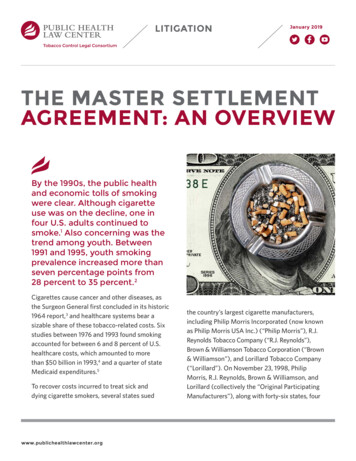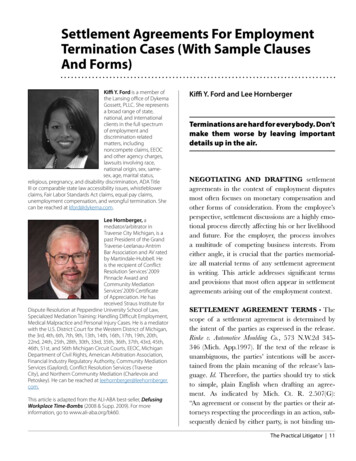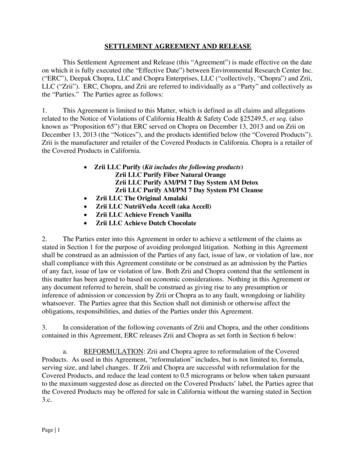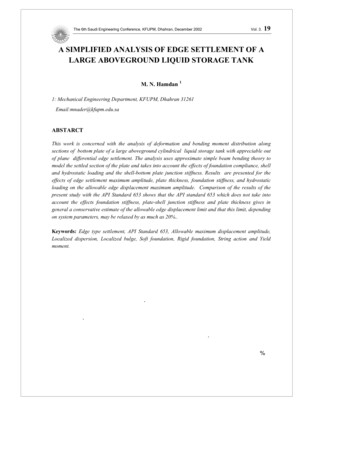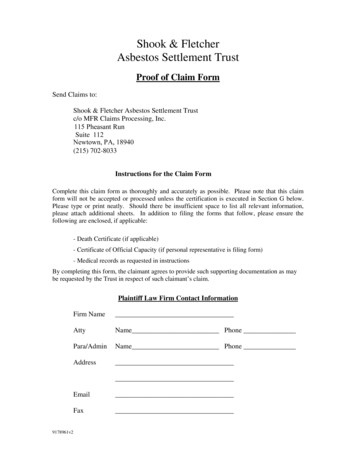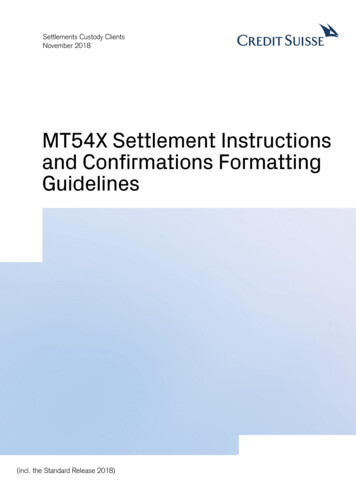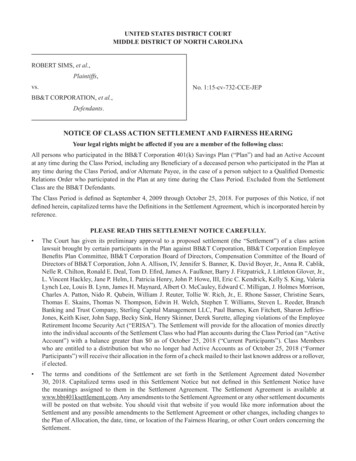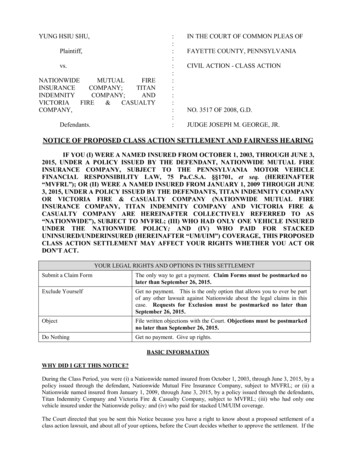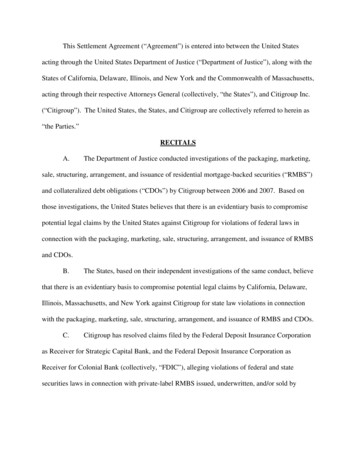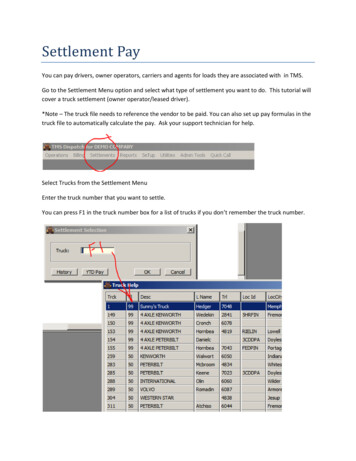
Transcription
Soil Compressibility &SettlementFaculty of Engineering – Cairo UniversityThird Year CivilSoil MechanicsSpring 2015Soil Settlement Settlements are vertical deformations of a soilmass under the effect of an applied stresscausing vertical movement of the supportedstructureSettlements are one of the safety andperformance criteria in geotechnical assessmentof structuresExcessive settlements can result in structuraldamage to a building frame, or loss offunctionality.Soil Mechanics –SoilThirdYear CivilEng.Mechanics(PBWN302)1
Soil SettlementSoil Mechanics –SoilThirdYear CivilEng.Mechanics(PBWN302)Soil Settlement Uniform settlements: equal settlements across thearea of the structureDifferential settlements: unequally foundationsettlements in different areas of the structure.Differential settlement can result in severe structuraldamage while uniform settlements are of lessconsequencesSoil Mechanics –SoilThirdYear CivilEng.Mechanics(PBWN302)2
Soil Settlement Differential settlementsSoil Mechanics –SoilThirdYear CivilEng.Mechanics(PBWN302)Soil Settlement Differential settlementsSoil Mechanics –SoilThirdYear CivilEng.Mechanics(PBWN302)3
Define: Compressibility Compressibility: is the property through whichparticles of soil are brought closer to each other, dueto escapage of air and/or water from voids under theeffect of an applied pressure.Soil Mechanics –SoilThirdYear CivilEng.Mechanics(PBWN302)Settlement of Cohesive SoilsCoefficient of compressibility (av):is the rate of change of void ratio (e) with respect to theapplied effective pressure (p) during compression.av e peo initial void ratiopo initial effective stresse1 final void ratiop1 final effective stress e eo – e1 p p1 – poeeoe1e-p curve e ppop1pSoil Mechanics –SoilThirdYear CivilEng.Mechanics(PBWN302)4
Settlement of Cohesive SoilsCoefficient of volume compressibility (mv):is the volume decrease of a unit volume of soil per unit increaseof effective pressure during compression.ΔeVsΔVV(1 e o )Vs1 Δeavmv o ΔpΔp(1 e o ) Δp (1 e o )eoVsInitial ConditionFinal ConditionSoil Mechanics –SoilThirdYear CivilEng.Mechanics(PBWN302)Settlement of Cohesive SoilsFor a thin layer, p at mid depth is considered as anaverage stress within the layer.qΔH VΔe HV(1 e o )ΔH S S ΔeΔe ΔpH H(1 eo )ΔP (1 eo )avΔpH(1 eo ) pHClayS m v ΔpHwhere:S settlementmv coefficient of volume compressibility p stresses at mid depth of layer due toadded loadsH total thickness of layer e Heo1 eoH1Soil Mechanics –SoilThirdYear CivilEng.Mechanics(PBWN302)5
Settlement of Cohesive SoilsFor a thick layer, the layer may be divided to number ofsub-layers, each of thickness Hi. The stress at mid-depthof each sub-layer is pi.qS m vi Δp i H i p1H1 p2H2ClaySoil Mechanics –SoilThirdYear CivilEng.Mechanics(PBWN302)Settlement of Cohesionless Soils Sand may be considered as an elastic material withYoung’s modulus (E)Young’s Modulus (E): is the slope for the linear portion ofthe stress-strain curve.strain 1 stress E HH 1 pES p H E1S pHEqH pSandE 100 (v. loose) - 800 (v. dense) kg/cm 2Soil Mechanics –SoilThirdYear CivilEng.Mechanics(PBWN302)6
ExampleCompute the settlement dueto compressibility of the sandand clay layers at points (a)and (b) of the building shownin the figure. The building hasa basement and is foundedon raft foundation. The stressfrom the building at thefoundation level is as shownin the figure.Sand: 1.70 t/m3 E 500 kg/cm2Clay: mv 0.03 cm2/kgSoil Mechanics –SoilThirdYear CivilEng.Mechanics(PBWN302)Exampleqnet q – h 20 – 1.70x3.0 14.9 t/m2For sand layer:z 5.0 m 1” 2.5 cmL 30 m 30x2.5/5.0 15.0 cm, B 20 m 20x2.5/5.0 10.0 cm,na 191 a,sand na/200 (qnet) 191/200 x 14.9 14.2 t/m2nb 50 b,sand nb/200 (qnet) 50/200 x 14.9 3.7 t/m2abSoil Mechanics –SoilThirdYear CivilEng.Mechanics(PBWN302)7
Exampleqnet q – h 20 – 1.70x3.0 14.9 t/m2For clay layer:z 11.0 m 1” 2.5 cmL 30 m 30x2.5/11 6.8 cm, B 20 m 20x2.5/11 4.5 cmna 144 a,clay n/200 (qnet) 144/200 x 14.9 10.7 t/m2nb 47.3 b,clay n/200 (qnet) 47.3/200 x 14.9 3.5 t/m2abSoil Mechanics –SoilThirdYear CivilEng.Mechanics(PBWN302)ExampleSa Ssand SclaySsand 1/E a,sandHH 10.0 mE 500 kg/cm2 a,sand 14.2 t/m2Ssand 1/500 x 14.2/10 x 1000 2.84 cmSclay mv a,clayHH 2.0 mmv 0.03 cm2/kg a,clay 10.7 t/m2Sclay 0.03 x 10.7/10 x 200 6.42 cmSa Ssand Sclay 2.84 6.42 9.26 cmSoil Mechanics –SoilThirdYear CivilEng.Mechanics(PBWN302)8
ExampleSb Ssand SclaySsand 1/E b,sandHH 10.0 m b,sand 3.7 t/m2E 500 kg/cm2Ssand 1/500 x 3.7/10 x 1000 0.74 cmSclay mv b,clayHH 2.0 mmv 0.03 cm2/kg b,clay 3.5 t/m2Sclay 0.03 x 3.5/10 x 200 2.1 cmSb Ssand Sclay 0.74 2.1 2.84 cmSoil Mechanics –SoilThirdYear CivilEng.Mechanics(PBWN302)Time of settlement compared to constructiontime Loading DiagramPConstruction period TimeTimeSettlement of Sand1S pHESTime Settlement of ClayS m v ΔpHSSoil Mechanics –SoilThirdYear CivilEng.Mechanics(PBWN302)9
Causes of Settlement Static Loads Dynamic Loads Groundwater table lowering Loads from adjacent buildings Capillary forcesSoil Mechanics –SoilThirdYear CivilEng.Mechanics(PBWN302)Theory of Consolidation Consolidation: is the process of squeezing water outof saturated soil under the effect of loads. In sandy soils, high permeability, drainage of water outof the soil under the effect of loading happensimmediately. In clay soils, low permeability, drainage of water out ofthe soil under the effect of loading is time dependent. Therefore, parameters governing consolidation processinclude: soil properties, stress (p), time (t), drainageconditions.Soil Mechanics –SoilThirdYear CivilEng.Mechanics(PBWN302)10
Mechanism of Consolidation ProcessAnalogy:Confined saturated soil(solids and voids filledValve soilpermeabilityPiston forloadingwith water)VersusContainer filled withwater that has a springWater pore-waterand a valveRemember: water isSpring SolidsContainerincompressibleSoil Mechanics –SoilThirdYear CivilEng.Mechanics(PBWN302)Mechanism of Consolidation ProcessFor Sands: high permeability valve is open, water gets outimmediately (t 0), excess pore water pressure u 0Stress pAt t 0 (immediately),Load carried by spring u 0Soil Mechanics –SoilThirdYear CivilEng.Mechanics(PBWN302)11
Mechanism of Consolidation ProcessFor Clays: low permeability valve is partially open, watergets out slowly (time-dependent), u decreases with tStress pStress pAt t 0 (immediately), u pSpring carry no loadAt t t1, 0 u pLoad carried by water and springSoil Mechanics –SoilThirdYear CivilEng.Mechanics(PBWN302)Mechanism of Consolidation ProcessFor Clays:Stress pStress pAt t t1, 0 u pLoad carried by water and springAt t long time, u 0Load carried by springSoil Mechanics –SoilThirdYear CivilEng.Mechanics(PBWN302)12
Mechanism of Consolidation Process If we apply a certain load, and the valve is closed, thenwater (incompressible material) carries the entireadded load.If the valve is opened, water flows out, and thus itsvolume is reduced.As volume is reduced, the spring starts to becompressed and carries part of the load. Meanwhile,excess pore water pressure decreases.The process continues until sufficient amount of waterescapes from the valve, resulting in compression of thespring to carry the entire load.At this point, the excess pore water pressure decreasesto zero, the spring carries the entire load, the system isin equilibrium.Soil Mechanics –SoilThirdYear CivilEng.Mechanics(PBWN302)Application on Soil Stress distribution before application of loadGWTGSSandClayGravelσtuσ'Soil Mechanics –SoilThirdYear CivilEng.Mechanics(PBWN302)13
Application on Soil Short time (immediately) after application of q (t 0)GWTGSqSandqClayqqGravelquσtσ'Soil Mechanics –SoilThirdYear CivilEng.Mechanics(PBWN302)Application on Soil Long time after application of q (t h)GWTGSqSandqClayqGravelqσtuσ'Soil Mechanics –SoilThirdYear CivilEng.Mechanics(PBWN302)14
Application on Soil Total stress:σ t Σγh q Pore water pressure: t 0 u γ whw q u γ wh w t h u γ wh w u γ wh w(clay)(sand)(clay)(sand) Effective stress: t 0 σ' Σγ'h σ' Σγ'h q(clay)(sand) σ' Σγ'h q σ' Σγ'h q(clay)(sand) t hAt time t ?Soil Mechanics –SoilThirdYear CivilEng.Mechanics(PBWN302)Rate of ConsolidationGWTGSqSandt 0ClayqqqGravelqσtuσ'Soil Mechanics –SoilThirdYear CivilEng.Mechanics(PBWN302)15
Rate of Consolidationut 0t t1Clayt t2t t3t qSoil Mechanics –SoilThirdYear CivilEng.Mechanics(PBWN302)Assumptions of Theory of Consolidation1.Clay is homogeneous, isotropic, and saturated2.Water and clay particles are incompressible3.Darcy’s law is valid4.The clay layer is laterally confined5.One-dimensional compression, and one-dimensionalflow6.Consolidation parameters from test applies to claylayer from which sample for test was taken7.Soil properties are constant with timeSoil Mechanics –SoilThirdYear CivilEng.Mechanics(PBWN302)16
Consolidation Test Objectives: Volume change-effective pressure relationship Stress history of soil Volume change – time – pore water dissipation relationshipSoil Mechanics –SoilThirdYear CivilEng.Mechanics(PBWN302)Consolidation TestDial gaugeCompressioncellLoadLoading frameSoil Mechanics –SoilThirdYear CivilEng.Mechanics(PBWN302)17
Consolidation TestDial gaugeCompressioncellLever ArmLoadConsolidation Testset-upSoil Mechanics –SoilThirdYear CivilEng.Mechanics(PBWN302)Consolidation TestDial gaugeCompressioncellLever ArmLoad PoConsolidation Testset-upSoil Mechanics –SoilThirdYear CivilEng.Mechanics(PBWN302)18
Consolidation TestLoading HeadDial gaugeMetal ringSaturatedsamplePorous stoneFilter paperCompression Cell/OedometerPorous stoneSoil Mechanics –SoilThirdYear CivilEng.Mechanics(PBWN302)Consolidation TestLoading HeadMetal ringSaturatedsampleLoad (P1)Dial gaugePorous stoneFilter paperCompression Cell/OedometerPorous stoneSoil Mechanics –SoilThirdYear CivilEng.Mechanics(PBWN302)19
Consolidation Test Equipment:1.Compression cell / Oedometer2.Loading frame to apply weights (Po)3.Dial gage to measure soil compressionNote:Load acting on the cell (P1) is magnified by the lever armratio of the loading frame (LAR), where: P1 LAR x PoSoil Mechanics –SoilThirdYear CivilEng.Mechanics(PBWN302)Consolidation Test Procedure:1.Trim the sample into the metal ring and place filter paperon both sides of sample.2.Measure initial conditions of sample: ho, eo, wo, Gs3.Place the ring into the compression cell between the twoporous stones.4.A metal cap (loading head) is placed over the top porousstone, on which the load (P1) is applied.5.Set-up the dial gage to zero reading. Fill the compressioncell with water until the top porous stone is covered withwater.Soil Mechanics –SoilThirdYear CivilEng.Mechanics(PBWN302)20
Consolidation Test Procedure:6.Place the hanging load (Po) such that the pressure on theclay sample is equal to the first loading step.7.Record readings of dial gage (compression of sample)with time until compression stops (usually within 24hours).8.Repeat steps 6 and 7 for subsequent loading andunloading increments.Soil Mechanics –SoilThirdYear CivilEng.Mechanics(PBWN302)Consolidation Test Loading scheme, for example: 0.25, 0.5, 1.0, 2.0, 4.0, 8.0, 16.0 (kg/cm2) 16.0, 4.0, 1.0, 0.25(kg/cm2)LoadingUnloadingResults: for each loading/unloading increment, werecord: dial gage ( h) that measures samplecompression versus elapsed time (t).Soil Mechanics –SoilThirdYear CivilEng.Mechanics(PBWN302)21
Consolidation Test Data ReductionFor each loading increment, plot h-log t: 0.11Time (min)10100100001020 h (x 10-2 mm)30405060708090100Soil Mechanics –SoilThirdYear CivilEng.Mechanics(PBWN302)Consolidation Test Data Reduction At the end of each loading increment:1.Calculate effective pressure (p) Load x LAR/sample area2.Measure h sample compression during this loadingincrement3. eCalculate void ratio (e): e h 1 eo ho heo1 eoho1e eo – e Plot e-p curveSoil Mechanics –SoilThirdYear CivilEng.Mechanics(PBWN302)22
Consolidation Test Data ReductionExample:LAR 3, sample area 41.85 cm2, ho 2.54 cm, eo 0.636Load (kg)0714.5295811623208913522335955070507 x 3/41.85 0.501.042.084.168.3216.6300.89/25.4 (1 0.636) 73 0.57870.54900.49240.40480.28170.1819Dial Reading x 10-2 (mm) hStress (p) Load x lever armratio/area (kg/cm2) e h/ho (1 eo)e eo - eSoil Mechanics –SoilThirdYear CivilEng.Mechanics(PBWN302)Consolidation Test Data ReductionPlot e-p curve:0.70.60.5e0.40.30.20.100510p (kg/cm2)1520Soil Mechanics –SoilThirdYear CivilEng.Mechanics(PBWN302)23
Consolidation Test Data ReductionFrom e-p curve, for a certain stress range, calculate av and mv, where:e eav peoe1avmv (1 e o ) e ppop1pSoil Mechanics –SoilThirdYear CivilEng.Mechanics(PBWN302)Consolidation Test Data ReductionPlot e-log(p) curve:0.70.60.5eoe0.4 e0.3e1 log(p)0.20.100.11po10p1100p (kg/cm2)Soil Mechanics –SoilThirdYear CivilEng.Mechanics(PBWN302)24
Consolidation Test Data ReductionFrom e-log(p) curve, the slope of the linear portion is the Compression Index (Cc):Cc e log( p )Determine preconsolidation pressure (pc): is the largest effective pressure that has been applied on the soil in itsgeological history.Soil Mechanics –SoilThirdYear CivilEng.Mechanics(PBWN302)Consolidation Test Data ReductionDetermination of preconsolidation p (kg/cm2)Soil Mechanics –SoilThirdYear CivilEng.Mechanics(PBWN302)25
Determination of PreconsolidationPressure1.Determine point of maximum curvature (a).2.At (a), draw tangent to e-log(p) curve.3.At (a), draw horizontal line.4.Draw a bisector to the angle enclosed between thetangent and horizontal lines.5.Extend the linear portion of the
Faculty of Engineering – Cairo University Third Year Civil Soil Mechanics Spring 2015 Soil Mechanics – Third Year Civil Eng.Soil Mechanics (PBW N302) Soil Settlement Settlements are vertical deformations of a soil mass under the effect of an applied stress causing vertical movement of the supported structure Settlements are one of the safety and performance criteria in geotechnical .
